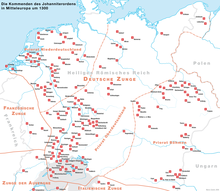Tongues of the Order of Malta
Tongues , in the sense of tongue as a synonym for language, was the name of the country team of the Order of Malta from the 14th to the 18th century . They corresponded in their function roughly to the provinces of other religious orders.
This form of organization emerged at the beginning of the 14th century when the Order took possession of the island of Rhodes . It was decided at a general chapter of the order held in 1301 . Initially there were seven tongues: Provence, Auvergne, France, Italy, Aragon (with Navarre), England (with Scotland and Ireland) and Germany. In 1462, Castile and Portugal separated from Aragon and formed their own eighth tongue.
Through the processes during the Reformation, individual tongues (e.g. the English and German) were so weakened that they could no longer perform these functions, so that a reorganization took place. In the 18th century there was a Bavarian tongue for a short time , this contained the lost tongues of Germany and England.
organization
As can be easily seen from the names of the tongues, their division did not correspond to the language boundaries, but mostly comprised knights and religious settlements of several nations. For example, all knights from the Scandinavian countries as well as those from Hungary, Poland and Bohemia belonged to the German tongue.
Each tongue had at least one grand priory. The Grand Prior and the chapter sent by the Balleien and Kommenden directed the individual branches of the order. In their district they were responsible for the administration of the order's property, the maintenance and supervision of the charitable works of the order (hospitals, etc.). They also had to take care of the granting of benefices , for example parishes that were incorporated into the order. Last but not least, the tongues paid financial contributions for the defense of Rhodes (from 1530 Malta ) against the Turks and for the maintenance of the order's fleet in the Mediterranean.
But they were also represented directly in the order headquarters. On the one hand, they sent knights of the order to the general chapter, on the other hand, each tongue was assigned a part of the fortifications on Rhodes for defense. Every tongue had to fill this section with enough knights and mercenaries. Each tongue had its own house there, where their relatives would gather and eat meals together. A similar procedure was later followed in Malta.
Overview of the order structure after the reorganization of 1301
- Tongue of Provence : includes the south of France, with two major priories in Toulouse and Saint-Gilles
- Auvergne tongue : Central France, with the Grand Priory of Bourganeuf
- French tongue : Great Priory France, with northern and western France; In 1317 divided into the greater priories of Aquitaine (Poitiers), Champagne and France
- Tongue of Aragon : the Iberian Peninsula, with major priories for Aragon (Amposta), Catalonia, Castile and León, Navarre, and Portugal,
- Division 1462:
- the great priories of Amposta, Catalonia and Navarre form the tongue of Aragon ;
- the great priories of Castile-León and Portugal form the tongue of Castile
- Italian tongue : with the grand priories Messina, Barletta, Capua, Rome, Pisa, Lombardy and Venice
- English tongue : with the great priories of England, Scotland and Ireland
- German tongue : with the major priories of Bohemia, Upper and Lower Germany, Dacia (= Denmark, Sweden), Poland and Hungary
Development in the 18th century

After the dissolution and abolition of the Jesuit order in 1773, Elector Karl Theodor von Bayern founded a "Bavarian-English tongue" of the Order of Malta from parts of his property to care for his natural son Karl August von Bretzenheim (1768–1823).
Although the English language practically no longer existed since the order was driven out by King Henry VIII , the Order insisted on its legal existence. King George III von England gave its consent to the connection of the newly planned Bavarian tongue with the tongue of England and to give it the name "English-Bavarian tongue". The Vicar General of the Bavarian Grand Priory and later Cardinal Johann Casimir Häffelin played a key role in the official establishment of the Anglo-Bavarian Tongue of the Order of Malta with the new Grand Priory of Bavaria between December 1781 and April 1782 . As a boy, Karl August von Bretzenheim became Grand Prior of the Bavarian Order of Malta and the Order of St. George with corresponding ongoing appanage .
The French Revolution and the Third Partition of Poland (Austria, Prussia and Russia) in 1795 also changed the position of the Order of Malta. Tsar Paul became the protector of the Polish priory and established an orthodox Polish-Russian priory, which he converted to the Order of Malta with the English-Bavarian tongue by decrees of the order in 1797 (before Napoleon conquered Malta in June 1798) Association.
Later in the Peace of Amiens (1802), France and England negotiated that no member of these two nations could be a member of an ecclesiastical knightly order. The English-Bavarian-Russian tongue of the Order of Malta became the "Bavarian-Russian tongue".
In 1806 the states of the Rhine Confederation decided to dissolve the German Grand Priory and to expropriate the entire possessions of the Order in its member countries. In 1808, the Maltese holdings were secularized in the Kingdom of Bavaria by King Maximilian I Joseph .
See also
literature
- Bertrand Galimard Flavigny: Histoire de l'ordre de Malte. Perrin, Paris 2006, ISBN 2-262-02115-5 .
